From Bakelite to Biodegradable: Practical Initiatives for Broadband Spectroscopy in Plastic Remediation and Replacement
In a world where plastic pollution can be seen out most windows, no article is needed to convey the global scope of the plastics problem. But this topic often becomes bifurcated into technological discussions without concrete implementations, or broad initiatives without a tether to the aforementioned technologies. Here we aim to fuse these two by connecting the capabilities of ultraviolet (UV), visible (VIS), near-infrared (IR), and Raman spectroscopies with practical, real-world initiatives being carried out at the corporate and social levels. Spectroscopy plays a critical role in both macroscopic and microscopic plastics detection, which is the first step in remediation, and also in the commercial replacement of plastics with biodegradable materials. This piece provides tangible examples of efforts being made today, including details on spectral hardware implementation, but more importantly provides proposals to the reader on how they can make a meaningful difference in their own world.
Do you hate litter? I sure do. Back in middle and high school, my friends would jokingly call me “Captain Planet” for always picking up any trash laying around. Today it is everywhere, with almost every road or waterway having some trace of trash obvious at a passing glance. This is a sad way to start the article, but don’t leave yet! This should be a fun one in the end, with a smorgasbord of content that hopefully does something a little different.
Typical tech articles, like what you may be expecting here, will show amazing capabilities, but not necessarily tie them to real-world initiatives. Conversely, more socially minded articles will talk of great aspirations, but lack the tangible technologies and solutions that drive those goals. Here, we look to fuse these two by providing a combination of some interviews, relevant ultraviolet/near-infrared (UV/NIR) and Raman scans of traditional and biodegradable plastics, and some true examples of what companies, organizations, and individuals are doing to remediate plastic pollution. Make no mistake that the hero in all of this, which is why you’re reading it where you are, is broadband spectroscopy and the penetrating methods it offers.
Any type of litter is bad, but roofers and boat owners know firsthand that wood and metal at least corrode naturally over time. Plastics, however, are a bad deal; governing bodies as progressive as California and conservative as the Vatican have moved to ban single-use plastics, and for good reason (1). The clear majority (about two-thirds) of the half-billion tons of plastics produced annually are for single or short-term use, and this is set to triple by 2060 (2). This single-use plastic wreaks havoc on our waterways more than anywhere else, with the equivalent of 2000 garbage trucks filled with plastic being dumped into oceans, lakes, and rivers every day. Two thousand truckloads every day, day after day, never relenting and continually increasing. This article will somewhat bifurcate plastic pollution into two categories: macroscopic and microscopic. We’re all familiar with macroscopic litter, the soda bottles and food wrappers that fill any ditch you walk by, and we are now hearing more about the microscopic version and its increasingly scary findings. Luckily, the physics that drive spectroscopy largely don’t care about size, and we can apply similar techniques to different problem scenarios with some clever modifications.
Size Matters
Let’s start with the big stuff, the macroscopic litter that we see lining our roadways and drainage canals. The effect of these is more obvious since it directly chokes wildlife, such as sea turtles mistaking a plastic bag for a jellyfish, and can even choke entire waterways, which end up altering ecosystems and becoming a breeding ground for mosquitoes and the diseases they carry (3). Besides the terrestrial pollution we see in our communities, or the aquatic devastation we just mentioned in oceans and rivers, these macroplastics are causing an increase in something less expected: Aliens!
About a year ago I was in Spokane, Washington, more specifically in the small town of Mead just north of the city, fueling up the rental car when myself and fellow gas guzzlers gazed up in amazement at this large dark orb hovering ominously in the sky. It looked pretty hefty, definitely over a hundred pounds, but just sat there in place until it suddenly jerked to a new location, causing a unanimous “Oooo!” from the crowd. Well, I finish fueling, and drive up to the stop light while still watching this large orb hovering. It begins to slowly descend in my general direction, eventually settling on the passenger side of the rental. It was a black lawn bag weighing no more than several grams that was caught up in a wind current. Don’t worry—”Captain Planet” got out of the car and collected it.
Now, this is not to anger or argue against anyone who follows UFO-culture, but it is simply to highlight an important finding of the recent congressional hearings on UFOs which noted that the majority of the 140 reports since 2004 could be explained by either drones or “airborne trash” (4). Land, sea, and air…plastic pollution is everywhere!
So what do we do about this macroscopic plastic litter? Collect it, recycle it, and make the next generation with a smarter material. This captures the three-prong initiative presented by the UN called “Turn Off The Tap,” which advocates accelerating three key shifts: Reorient and diversify, reuse, and recycle (5).
There’s a story I’ll tell at the end about an old roommate and recycling, but this is the one we’ve probably heard the most about. The aforementioned UNEP report notes that “only” nine percent of plastics are recycled, though I personally would have guessed this number to be far lower. Recycling can be tough, because you have to know exactly what polymers you’re dealing with to categorize items into the right chemical process, but the first step in recycling is gathering the recyclable material, and this is where our first spectroscopy solution comes in. It is neither the anticipated NIR nor Raman approach, because to find material across large areas requires a more optically responsive or sensitive technique. With UV spectroscopy, we can achieve far greater contrast and absorbance response, though sampling logistics may not always be straightforward. Table I summarizes the various techniques we’ll talk about, and our first entry of UV is the only approach essentially guaranteeing some optical response.
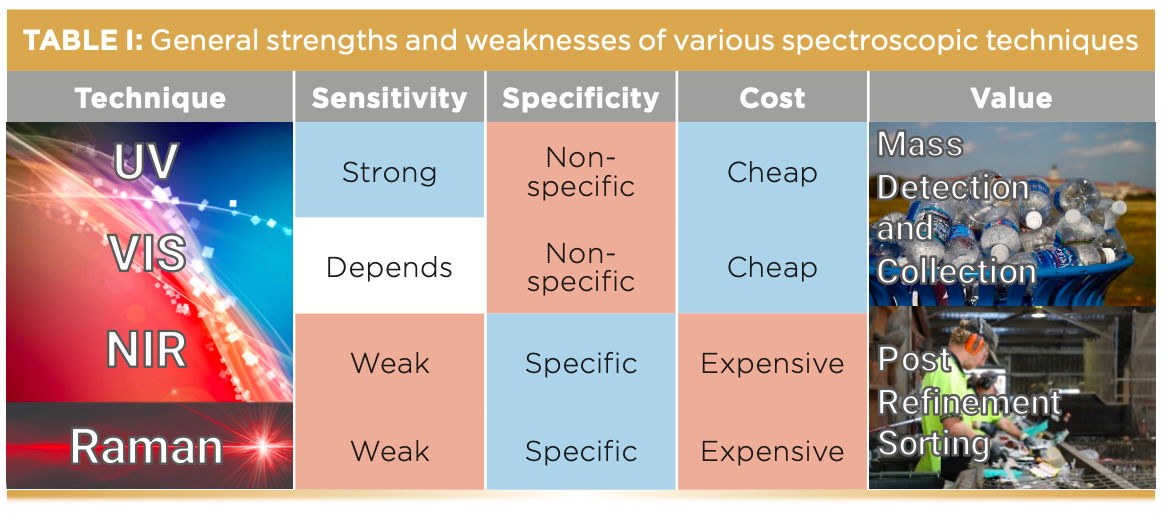
Since I fear I’m losing this science crowd by ranting about UFOs and the Vatican, let’s get to the spectroscopy. In Figure 1, we see the reflective absorbance response of several single-use plastics, including bags and eating utensils. Note that all six form factors exhibit strong response below 350 nm, which is a good general indicator that there are plastics in your bulk sample of water, soil, air, or what have you.
FIGURE 1: Reflective absorbance of various single-use plastic items in the UV-vis range. HR-6XR Bench, DH-2000 BAL Source, UV-vis Reflection probe.
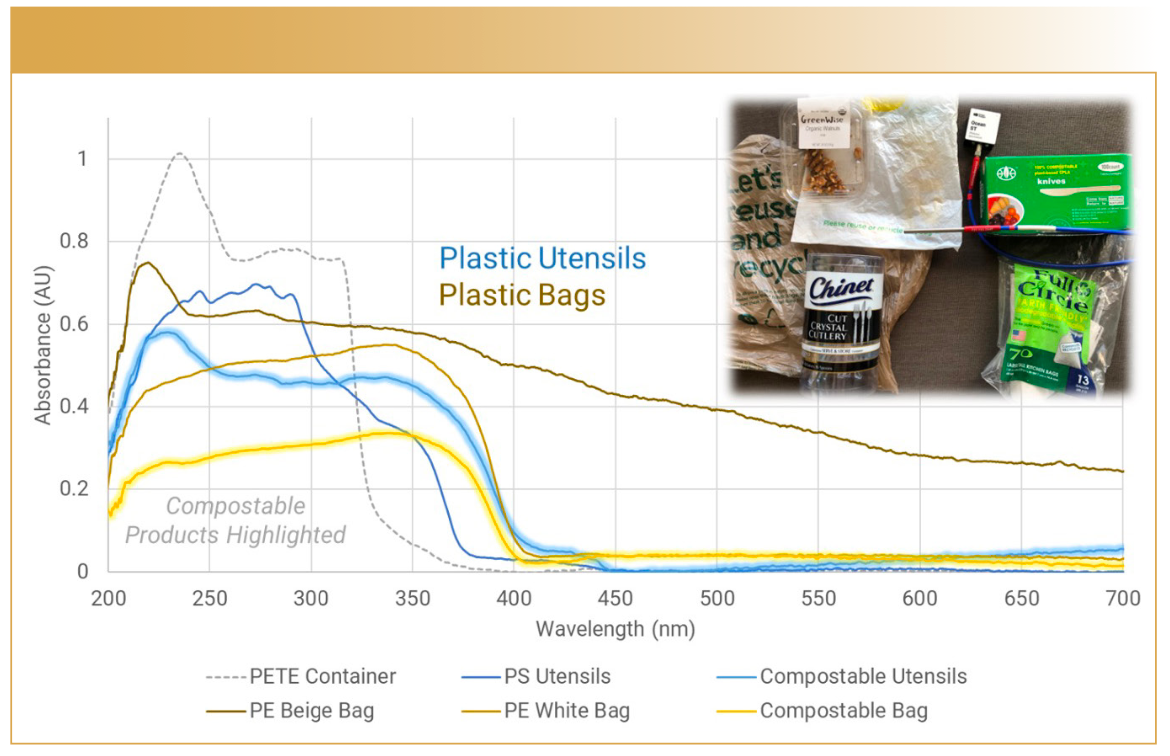
Everyone’s favorite Walkman producer, Sony, offers UV imaging systems for exactly this application, and their product page notes that speed is the key benefit due to large variance in UV activity (6). Having a bulk UV-scanner is an affordable way to detect plastics, but the potential downfall is the similar activity of biologicals. Proteins and most organic compounds will also show a strong UV absorbance, so it is important to differentiate between the “fake” jellyfish (the plastic bag) and the “real” jellyfish. This is where broadband spectroscopy coupled with rapid numerical method processing really shines, since we can leverage trends to quickly classify items. As mentioned, UV responses tend to be rather general and non-specific, but there are still some critical general features such as regional-slope that can tell more of a story. You can see the two highlighted trends are examples of compostable products for both bags and solid utensils. There are several key spectral differences to talk about for those, but before we do this is a good time to introduce our first guest interview.
A Corporate Cat-Herding Exercise
For this article, I had a chance to sit down with Michelle Singleton, an executive working in sustainability for a large FTSE100 company, to talk about her background and her thoughts on corporate initiatives around the plastics problem. She was born for this role, spending part of her New Zealand-based childhood selling handmade items to donate money to Greenpeace, and then growing up to achieve a master’s degree in carbon management and climate change science. She notes that we are very much in a period of conversion both in terms of technology and mindset, that “we’re just hitting that kind of early-to-mid transition hump that we are seeing with climate as well, where it’s all very well to make these grand statements, and the ambition has to be there and it’s great to see the ambition, but we need to back it up with real tangible plans, real strategies rather than just a goal which we don’t know how we’re going to achieve.” Technology can help, but it is the human ambition and mindset she mentions that turns these dreams into reality. “Where we have very short-lived items that don’t need to last long, then we shouldn’t be using a material that lasts in the environment for hundreds and hundreds of years,” Singleton said. “I think we need to see a mass mindset change, particularly among the consumer goods companies, about what you’re packaging, how you’re packaging, or how you’re creating products to actually use a material that’s appropriate for the use rather than just using plastic as a default because we’ve done it for 50 years.”
But getting companies to change is difficult, especially when there’s over $50 billion in annual revenue to be made (7). The number of companies and investors is not as large as you might think considering the amount of money and pollution involved; there are just 83 publicly traded companies operating above $100 million who derive at least 10% of that revenue from plastic containers and packaging. The 20 largest account for more than 60% of the sector’s revenue. This fortunately makes the cat-herding exercise a bit easier, versus having to lobby and convince hundreds of individual entities. Indeed, organizations are seeing the opportunity; in 2018, the Ellen MacArthur Foundation enlisted 150 companies to report on and reduce their plastics use by 2025 (2). While this sounds wonderful and reassuring, we have found ourselves somewhat in the position Singleton mentioned previously where these ambitions end up too quixotic, and without tangible methods to make them a reality they simply start to lose steam. Five years in, 20 companies have dropped out, having been unwilling or unable to meet the criteria to take part, such as setting quantitative targets and publicly reporting their progress. Even Lego has stopped a project to make bricks from recycled drink bottles instead of oil-based plastic, saying it would have led to higher carbon emissions over the product’s lifetime (8).
An old boss used to always say “every problem is an opportunity,” and that is true here as well. Consistency and discernment are two valuable tools to keep the tide moving in the direction you want, and even though we see some companies falling away from their commitments the majority are still in the running. Singleton had a good real-world example from a company in her group that makes various water testing technologies including common pool water test kits. “They actually redesigned that recently to change the whole housing to be 100% recycled plastic,” she said. “And they had lots of challenges with issues on the visibility and being able to see through it, and the fact that the recycled plastic actually changes color over the year depending on the mix. So that’s quite interesting when you’re using 100% recycled plastics, the clarity of plastic does change through the year depending on whether it’s summer and you’re getting lots of drink bottles versus winter and getting lots of whatever else.” Visible spectroscopy would be a valuable tool in this scenario to characterize and even potentially calibrate plastic housings used to display colorimetric pool readings. The browning of these plastics over time presents a unique difficulty often caused by UV light, yet sortable via VIS-range spectroscopy. The diligence to work through those difficulties pays off in the end, however, as it puts the business in a new and better position during this transitionary era—actually enabling this company to restart conversations with a lot of customers and drive quite a lot of new customer interest, “which I think is great,” Singleton said, “because that’s really where you see the change, when you see your customers actually want this, this can be a growth opportunity as opposed to ‘I have to do this for compliance reasons.”
Earth-Friendly Options Appear
Using recycled plastics is great, but back in Figure 1 we also highlighted some new compostable plastic technologies. Looking back at that graph, notice how the two traditional plastic solids (PETE container and PS utensils) have a deeper UV activity compared to the compostable plastics or even the traditional plastic bags. Those latter shoulders extend out to 400 nm, which can be a valuable bulk indicator of what you’re dealing with. Furthermore, the 300–350 nm region exhibits an inverted slope when comparing the traditional plastic utensils to the compostable ones. This would be a potential numerical method to implement during sorting, checking the absorbance slope over this region and mechanically shuffling the piece to the appropriate path. Compostable or biodegradable plastics can be made from either bio-based or traditional fossil raw material, but what ultimately matters is how and where they are designed to break down (9). Truly biodegradable plastics are meant to degrade in a specific medium such as water or soil over time. Compostable materials, such as what we present here, split into industrial or home composts, the former requiring more specific conditions for proper degradation. This isn’t as straightforward, then, as rejecting old plastics as bad and switching to the new good plastics; even within the realm of these new plastics we find environment, thickness, and polymer all play a key role (10). These items last much longer in terrestrial environments versus marine settings, likely due to lack of moisture and microbial activity. Thinner items will obviously fragment and degrade faster than thicker ones, and polymers like PHA degrade faster than PLA, with blending and lamination also playing a role.
Personally, I’ve made the switch to compostable garbage bags and various other items for my own home, and although they are more expensive today, this will hopefully assist the trend set by flatscreen displays and most other technologies. What am I talking about? In the year 2000, a 27” flatscreen monitor was around $4000, but today you can’t give one away. These new technologies are expensive while the manufacturers are paying down the capital equipment expenses; after so many years of operation, everything can start running on autopilot at a fraction of the cost. This requires consumer investment to drive popularity, which then drives down cost, which then drives further popularity. There are concerns with this solution as well, however. “There is a real future for ‘sustainable plastic alternatives,’ whether that’s bioplastics, or whether that’s more compostable alternatives, but we do need the recycling or the composting infrastructure, because I am worried that we are replacing one problem with another problem,” Singleton said. “And it’s an easy solution [to say] ‘Well, we’ll continue to use a single-use thing. We’ll just make it out of something different,’ and that obviously has an impact, whether that’s deforestation or carbon impacts from using paper instead. So, I just think we’ve got to be quite careful and think about what those alternatives are, not necessarily always taking the easiest option, and, really, we do have to actually just reduce the amount we’re using.”
One promising biomaterial is PHA, or polyhydroxyalkanoates, which can be made into countless common single-use form factors. Later in the article, we will hear from an amazing Canadian house DJ named BLOND:ISH and all of the great work she does, but one aspect of that fits in here with our discussion of biodegradable materials. Red Solo cups are ubiquitous in party scenes, at least in American culture, but the foundation led by BLOND:ISH has a new alternative. Working with Netherlands-based PHA production experts Happy Cups, the new cups are derived from the living bacteria present in recycled cooking oil to produce a strong, durable PHA material (PHBH) that is biodegradable, compostable and recyclable (11). These are the types of technologies that make the reorient aspect of the UNEP proposal very attractive.
The Color of Nature
We talked about the value of UV spectroscopy and how that is practically implemented by Sony as a sorting solution, but how does visible spectroscopy play a role? Looking at Figure 1, we see that everything except the beige bag has a flat absorbance response in the visible wavelengths (450–700 nm), and this is mainly due to those samples being clear or white. Indeed, many if not most plastics are clear or white, which makes VIS-range spectroscopy less useful. Think, though, about why certain trash stands out to you as you walk down the road; what makes you look at it? From red Coke bottles to neon candy wrappers, we see much plastic waste in colors that are not seen in the natural environment. This lends itself to creation of a library cataloging known color profiles of synthetics but also of animals. Nature is beautiful, and we do see many vibrant colors in fish, birds, insects, plants, and other flora and fauna that don’t need to be automatically scooped into a trash compactor. A group from the University of Eastern Finland proposes a novel autonomous aquatic drone that uses both visible and NIR wavelengths to detect and capture microplastics using this basis (12). This same approach can be applied to expanses of soil to detect both large and small plastics by their unique, unnatural colors.
Did you know you eat a credit card every week? That is the estimate of how much microplastic we now consume due to infiltration into the food chain, starting mainly in the oceans and working its way from fish to birds to larger predators (3). Do the math on that to realize every year we are consuming enough microplastic to make a 1.5-inch stack of credit cards, which doesn’t even include microplastics entering via inhalation and absorption. The health effects of this will not be verifiable for several generations, though one cannot omit the observation of dramatically increased cancer rates over modern decades. Just as the macroplastics choke organisms or clog entire waterways, microplastics cause similar issues on a smaller scale within the biological rivers of our bodies. Microplastics aren’t just plastic; they are also carriers of other pollutants due to the large specific surface area (13). Getting back to spectroscopy, this is where the NIR bands start to become valuable when implemented correctly. Jesús J. Ojeda and associates developed a method called focal plane array-Fourier transform infrared (FTIR) spectroscopy, which had great application potential for large-area and high-efficiency detection of microplastics. These upper wavelengths provide less optical interaction, but more specific fingerprinting for the particular plastic type. We’ve all seen the numbers inside the recycle symbols on various plastic pieces, and these correlate to plastic type which can be determined with NIR bands, as seen in Figure 2.
FIGURE 2: Example NIR trends of common recycled plastics.
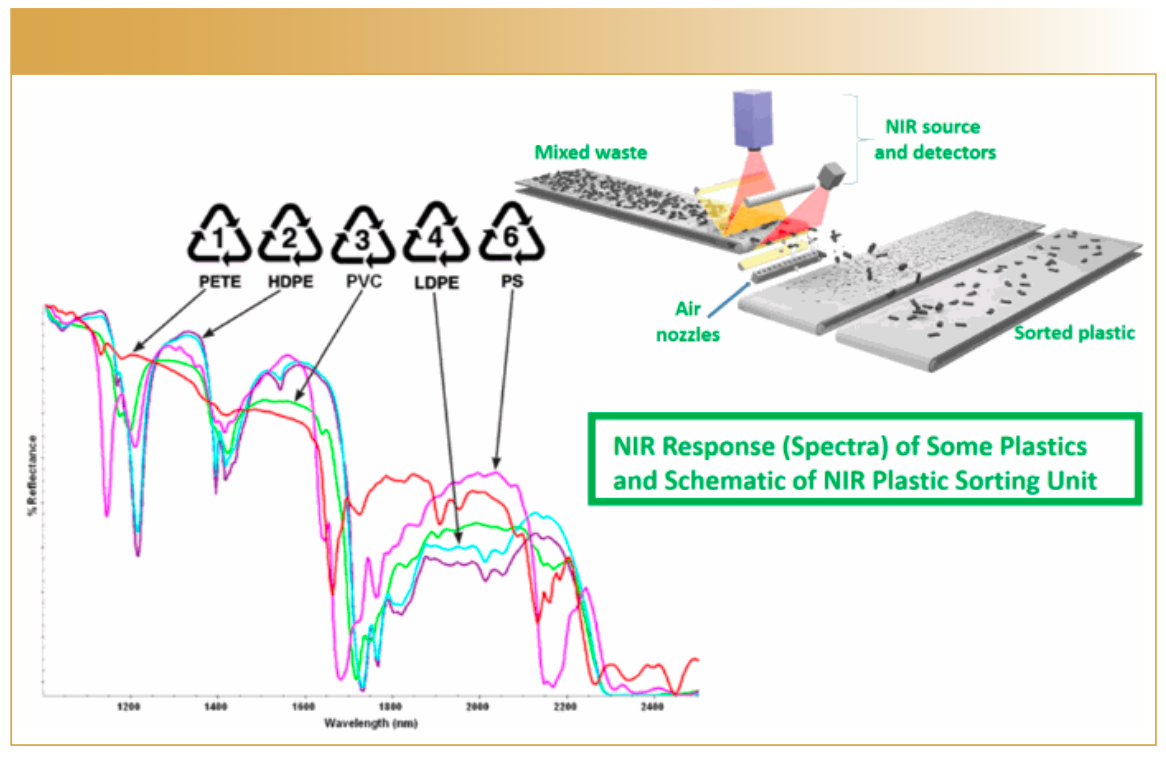
Note that two trends seen in Figure 2, including polyethylene terephthalate (PETE [#1]) and polystrent (PS [#6]), are also seen in Figure 1, which offer a useful comparison of the UV and NIR differentiators. The other useful tool here is Raman spectroscopy, which complements the NIR in the detection of microplastics because infrared activity and Raman activity of some substances are mutually exclusive (13). This is a laser technique, however, which does not necessarily lend itself to large areas or high throughput, since the optical emissions are often low and require longer scan times. The specificity, however, is fantastic, both for the plastic type and for the various additives or other components that may be present. Raman provides a deeper dive into the makeup of microplastics, or even bulk plastics. Typically, 785 nm lasers are used for their “sweet spot” of avoiding fluorescence seen with 532 nm systems or the jagged signals of 1064 nm systems. Another wavelength I’m particular to is 638 nm, especially for surface-enhanced Raman spectroscopy (SERS), since this wavelength can resonate with both gold and silver nanoparticle enhancers.
Turn Up The Volume
We’ve touched on how Sony offers UV-based systems for plastic detection and sorting, how the Finnish group proposes autonomous drones using Vis- and NIR-range spectral sensors, and how NIR is used in both micro- and macro-classification and recycling. All of these are relevant spectroscopic techniques being used to help the plastics crisis, but they are all at the process level, being done in the bulk environment or at some processing facility. But what about at the consumer level? What about the events where real people commit the initial sin of buying a single-use plastic product and improperly discarding it? There’s potential for spectroscopy to help here as well.
The other exciting interview for this article was with the internationally renowned DJ BLOND:ISH, who leads an organization called Bye Bye Plastic with co-founder Camille Guitteau. I had first seen her live at Hulaween and she was easily the top DJ set of the festival, and looking her up online led me to her Bye Bye Plastic initiative.
“Everyone has their Eureka moment, and mine was in Brazil in 2018, I was playing on a beautiful, lush kind of jungle-looking cliff party,” BLOND:ISH recalled. “The sunrise was coming up, and it was just the most beautiful scenery ever. And then, when everyone left, there was this mountain of water bottles where the cleaning ladies [were] cleaning up and that view with the beautiful sunrise, that difference and dichotomy was like, ‘Wow, I know everyone in the music industry, I can actually try and make this change.’”
Today, Bye Bye Plastic offers a range of services including an eco-rider, which artists use to establish their preference against single-use plastics at a performance venue, planting the seeds of change for both that venue and other artists within that network. The initiative has over 1500 DJs and artists signed up, including names like Idris Elba and Fatboy Slim. There’s also a store offering a brilliant selection of common single-use plastic items reimagined using bio-friendly materials, all entirely plastic-free.
Bye Bye Plastic is also trying to establish a new initiative where spectroscopy could play a key role: A plastic footprint calculator for the event sector. The vision is to show people quantitatively how their choices and actions have a footprint on our world. “Scanners and spectroscopy machines that could help identify and show people live like, ‘Look what’s in your drink right now. You didn’t think there was [plastic] in your shirt or x or y or z.’” So many items we don’t think of as plastic, such as fabrics and other apparel, indeed are made with those materials today. Stations of low-cost NIR scanners could be installed at a venue allowing concertgoers to scan and assess exactly how much plastic footprint they are responsible for. “I would go around the party doing that,” BLOND:ISH enthusiastically notes while envisioning a handheld tool, “Plastic Police, here we go!” Bye Bye Plastic offers an online tool called the Plastic QuickScan where an event is able to assess beforehand how earth-friendly it really is, and then BBP can determine which alternative products or approaches would best align with that particular scenario. And going back to “every problem is an opportunity,” the pandemic actually catalyzed Bye Bye Plastic to expand somewhat outside of the music space and into Web3 events involving blockchain, NFTs, cryptocurrency, and other modern digital trends. Think of how many global spectroscopy conferences could use such a novel and relevant initiative.
Closing Reflections
Hopefully this article has at least shown several real-world examples of technologies and entities taking action in the fight against plastic pollution, both macroscopic and microscopic. But what else can we do in our daily lives? In the same vein of learning from our discarded objects, we have an opportunity to learn from our discarded neighbors. How often have you seen a homeless person with a sign that says, “Anything Helps”? These are two profound words that can apply to essentially anything, whether a diet or exercise initiative, saving money, or making our world cleaner. The amount of litter seems so overwhelming that most neglect picking anything up because it seems futile, but let us remember that anything helps. To that end, this year I started a new habit every other Sunday of spending 40–50 minutes walking up and down the street with a garbage bag picking up litter. While the amount of trash may vary week-to-week, the one consistent occurrence is at least someone yelling “Thank you!” out their window. Perhaps seeing me will motivate them to pick up the next piece of trash they walk by. Perhaps reading this will motivate you to start a similar habit on one of your dirtier roads. Anything helps.
Earlier in the article I promised a story about a roommate. Many years ago, before I was environmentally conscious, I had a roommate from Vermont who was extremely ecologically minded. She had just moved to Florida, and our area did not offer curbside recycling, which she just could not comprehend. As a result, she would not let myself or our other roommate throw any plastic out in the regular trash, and we would instead collect it in an ever-growing pile in our backyard. This quickly got out of hand, with visiting family and other guests asking why we had a massive pile of plastic garbage in our yard. One week, she went back home to visit family, and my roommate Jon and I seized our chance to bag everything up and run it to the dump. When she returned and learned what we did, she was so angry you would have thought we killed her whole family. I tell this story because, back then, we thought she was crazy, but today, I will admit, I collect every piece of plastic waste from my home and walk it to my community recycling bin each Friday, just as she would want.
We all have an opportunity to change our lifestyles and priorities, whether by switching to biodegradable products, recycling our home waste, or going on local walks collecting litter. In a world where most hope to change others, the true challenge lies in being open and able to change ourselves. Even at your workplace, think about what you might mention to management about positive initiatives, and how spectral technologies may assist in that. If your company deals with incoming materials that are partially scrapped, consider an affordable UV or NIR system to help classify those items. The right light source coupled to a reflection probe or pair of collimating lenses will do wonders. Get creative with your specific area of work, knowing that these compounds offer large UV response and polymer-specific fingerprints in NIR and Raman. How would spectroscopy and plastics handling complement each other in your world? Taking just a little time to reflect on this may snowball into something larger, because in the end…anything helps.
Image 1: Several statistical highlights of the current global plastics problem.
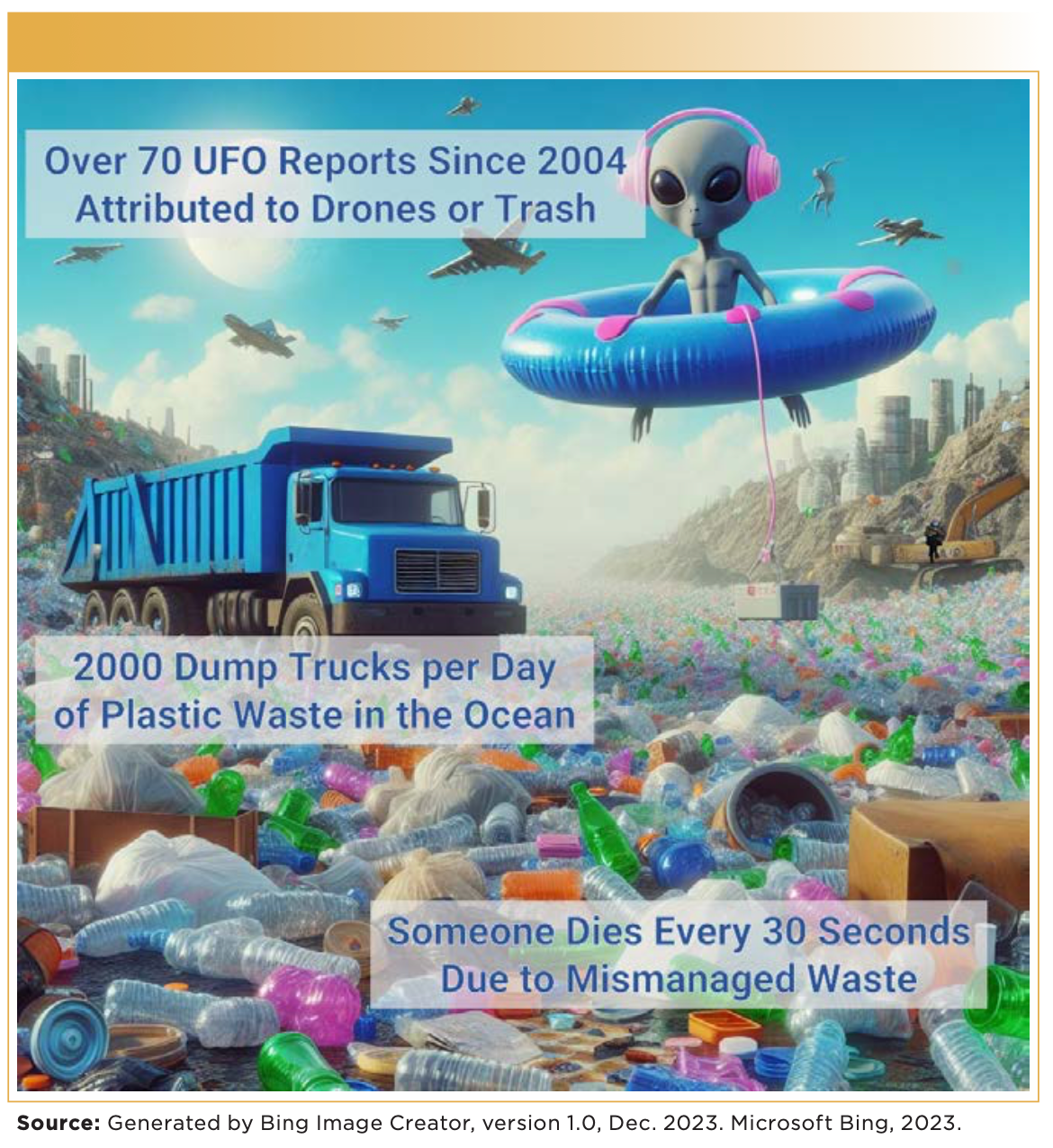
References
(1) Gomes, R. Vatican Doubles Green Effort with Waste Recycling. Vatican News. [Online] July 2019. https://www.vaticannews.va/en/vatican-city/news/2019-07/vatican-city-ecology-sorting-waste-plastic-environment-tornini.html
(2) Kaufman, L. Can a Global Plastic Treaty Stop the World from Choking on Pollution? Bloomberg. [Online] November 13, 2023. https://www.bloomberg.com/news/articles/2023-11-13/can-a-global-plastic-treaty-stop-the-world-from-choking-on-pollution?utm_source=website&utm_medium=share&utm_campaign=copy
(3) Schroder, P.; Barrie, J.; Wallace, J. A Future Without Plastic? Chatham House. [Online] August 26, 2022. https://www.chathamhouse.org/2022/08/future-without-plastic
(4) Lehrfeld, J. Pentagon Attributes UFO Sightings to Spies, Airborne Trash. Military Times. [Online] October 31, 2022. https://www.militarytimes.com/news/your-military/2022/10/31/pentagon-attributes-ufo-sightings-to-spies-or-airborne-trash/
(5) Milà i Canals, L.; et al. Turning Off The Tap. s.l.: United Nations Environment Programme, 2023. 978-92-807-4024-0.
(6) Ultraviolet Image Sensor Technologies. Sony Semiconductor Solutions Group. [Online] 2023. https://www.sony-semicon.com/en/technology/industry/uv.html
(7) Thoumi, G.; Willis, J. Unwrapping Investor Risk: Global Plastic Containers and Packaging Sector. s.l.: Planet Tracker, 2021.
(8) Bartholomew, J. Lego Abandons Effort to Make Bricks from Recycled Plastic Bottles. The Guardian. [Online] September 24, 2023. https://www.theguardian.com/lifeandstyle/2023/sep/24/lego-abandons-effort-to-make-bricks-from-recycled-plastic-bottles
(9) Biodegradable and Compostable Plastics— Challenges and Opportunities. European Environment Agency. [Online] European Environment Agency, August 2020. https://www.eea.europa.eu/publications/biodegradable-and-compostable-plastics
(10) 5Gyres. Do Biomaterials Break Down in Natural Environments? s.l.: 5Gyres, 2023.
(11) Holbrook, L. Plastic Free Party Meets Circular Beverages. Bye Bye Plastic. [Online] Bye Bye Plastic, November 27, 2023. https://www.byebyeplastic.life/post/plasticfreeparty-meets-circular-beverages-monkey-project-bye-bye-plastic-bring-pha-cups-to-ade
(12) Peiponen, K-E.; et al. Detecting Microplastics with Optics. Optics & Photonics News. [Online] Optica, November 2020. https://www.optica-opn.org/home/articles/volume_31/november_2020/features/detecting_microplastics_with_optics/
(13) Baruah, A.; et al. An Insight into Different Microplastic Detection Methods. Int. J. Environ. Sci. Technol. 2022, 19, 5721–5730. DOI: 10.1007/s13762-021-03384-1
Derek A. Guenther has a B.S. in Chemical Engineering from the University of South Florida with a minor in Inorganic Chemistry. His strengths and passions lie in new chemical sensor developments and spectral numerical processing. Derek has spent over 15 years at Ocean Optics developing and supporting the oxygen, pH, and SERS-based optical sensor products, running customer feasibility studies with the Lab Services group, and today he works with the Strategic Marketing Team to broadcast the excitement of spectroscopy out into the world. Direct correspondence to: derek.guenther@oceaninsight.com ●
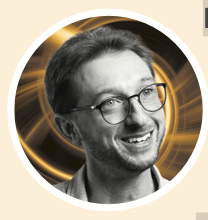
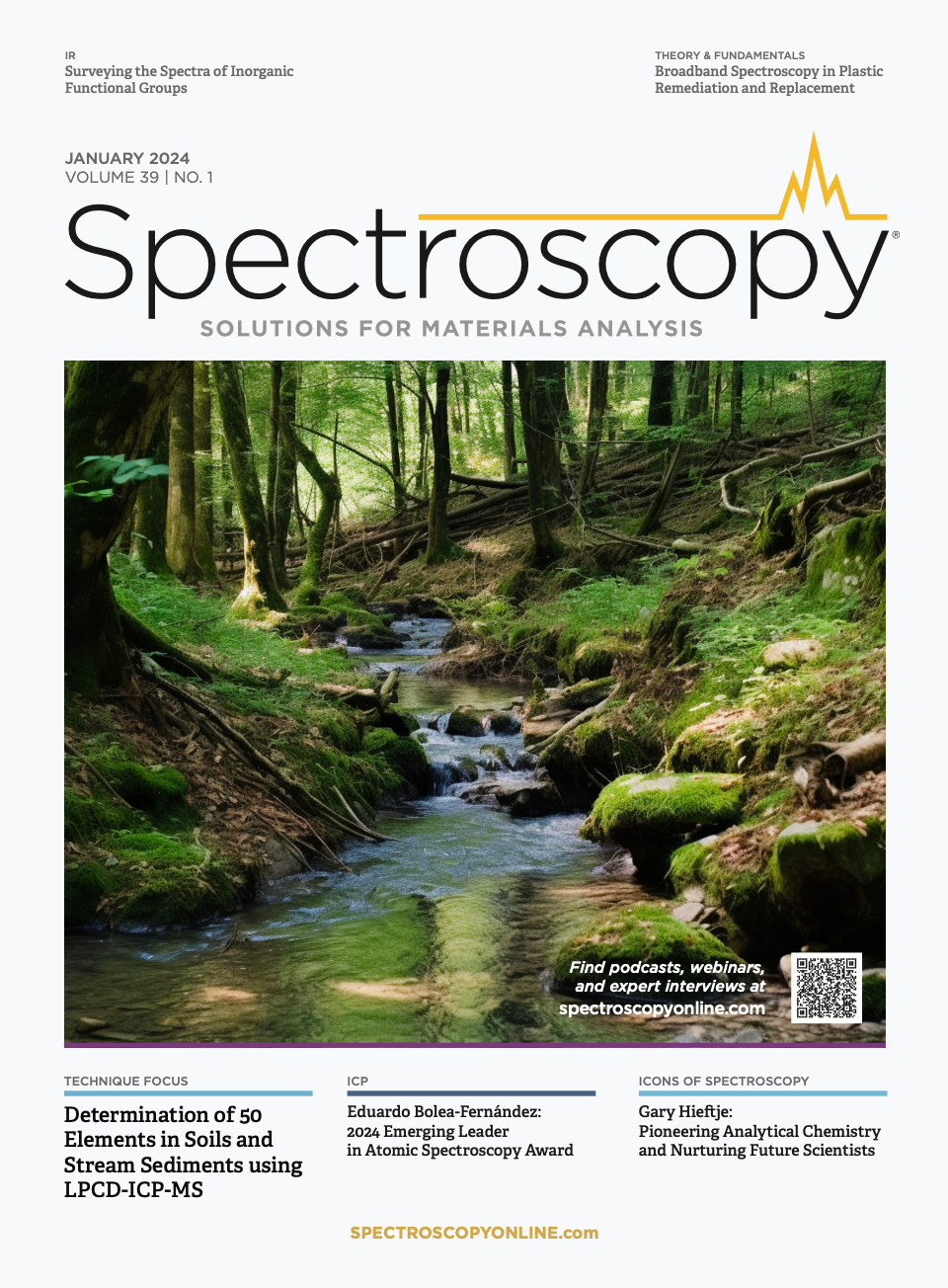
New Study Reveals Insights into Phenol’s Behavior in Ice
April 16th 2025A new study published in Spectrochimica Acta Part A by Dominik Heger and colleagues at Masaryk University reveals that phenol's photophysical properties change significantly when frozen, potentially enabling its breakdown by sunlight in icy environments.
Karl Norris: A Pioneer in Optical Measurements and Near-Infrared Spectroscopy, Part I
April 15th 2025In this "Icons of Spectroscopy" column, executive editor Jerome Workman Jr. details how Karl H. Norris has impacted the analysis of food, agricultural products, and pharmaceuticals over six decades. His pioneering work in optical analysis methods including his development and refinement of near-infrared (NIR) spectroscopy has transformed analysis technology. This Part I article of a two-part series introduces Norris’ contributions to NIR.
Real-Time Battery Health Tracking Using Fiber-Optic Sensors
April 9th 2025A new study by researchers from Palo Alto Research Center (PARC, a Xerox Company) and LG Chem Power presents a novel method for real-time battery monitoring using embedded fiber-optic sensors. This approach enhances state-of-charge (SOC) and state-of-health (SOH) estimations, potentially improving the efficiency and lifespan of lithium-ion batteries in electric vehicles (xEVs).